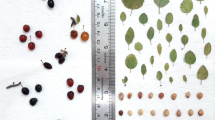Abstract
In this chapter, the standard and basis for Prunus mume taxonomy are being discussed. According to its morphological characteristics and distribution, P. mume can be classified into two ecological categories: high-elevation and low-elevation types. Within P. mume species, there are seven varieties and one variant.
Access this chapter
Tax calculation will be finalised at checkout
Purchases are for personal use only
Similar content being viewed by others
References
Bao M, Chen J (1992) Research status and prospects of Prunus mume (In Chinese). J Beijing For Univ S4:74–82
Bao M, Chen J (1994) Studies on the variation and distribution of Chinese Mei. Acta Hort Sin 21(1):81–86
Brickell CD, Baum B, Hetterscheid W, Leslie A, McNeill J, Trehane P et al (2004) International code of nomenclature for cultivated plants: introductory pages. Acta Hortic 647:7–20. https://doi.org/10.17660/ActaHortic.2004.647.1
Chen J, Bao M (1992a) Botanical classification and horticultural classification of Chinese mei (Prunus mume) resources. J Zhejiang For Coll 2:2
Chen J, Bao M (1992b) Studies on the classification of species (varieties, hybrids) and cultivars of Chinese mei (Prunus mume Sieb. et Zucc.). J Beijing For Univ S4:1–6
Chen J (1996) Chinese mei flowers (In Chinese). Hainan Publishing House, Haikou
Chen J, Chen R (2009) A new system for classifying China reference to developing superiorities groups Mei cultivar groups, with special of interspecific hybrid originated. Acta Hort Sin 36(5):693–700
Chu M (1999) Chinese fruit tree: Prunus mume (In Chinese). China Forestry Publishing House, Beijing
Chu M, Huang J (1995) Study on flower bud differentiation and metabolism of Prunus mume. J Beijing For Univ S1:68–74 (In Chinese)
Darlington CD (1940) Taxonomic species and genetic systems. New Syst 137-160
Doi H, Takahashi M, Katano I (2010) Genetic diversity increases regional variation in phenological dates in response to climate change. Global Change Biol 16(1):373–379. https://doi.org/10.1111/j.1365-2486.2009.01993.x
Hayashi K, Shimazu K, Yaegaki H, Yamaguchi M, Iketani H, Yamamoto T (2008) Genetic diversity in fruiting and flower-ornamental Japanese apricot (Prunus mume) germplasms assessed by SSR markers. Breed Sci 58(4):401–410
Jiang C, Ye X, Fang Z, Zhou D, Pan S (2017) Research progress on Japanese apricot (Prunus mume) in China (In Chinese). Southeast Gardening 5(5):26–31
Jianying ZXG (1997) Study on ecotypes of Prunus mume sieb. et zucc. in sichuan province. J Sichuan Agric Univ 2:148–150
Sokal RR, Crovello TJ (1970) The biological species concept: a critical evaluation. Am Nat 104(936):127–153
Author information
Authors and Affiliations
Corresponding author
Editor information
Editors and Affiliations
Rights and permissions
Copyright information
© 2019 Springer Nature Switzerland AG
About this chapter
Cite this chapter
Gao, Z., Shi, T. (2019). Taxonomy and Germplasm of Prunus mume. In: Gao, Z. (eds) The Prunus mume Genome. Compendium of Plant Genomes. Springer, Cham. https://doi.org/10.1007/978-3-030-10797-0_4
Download citation
DOI: https://doi.org/10.1007/978-3-030-10797-0_4
Published:
Publisher Name: Springer, Cham
Print ISBN: 978-3-030-10796-3
Online ISBN: 978-3-030-10797-0
eBook Packages: Biomedical and Life SciencesBiomedical and Life Sciences (R0)




